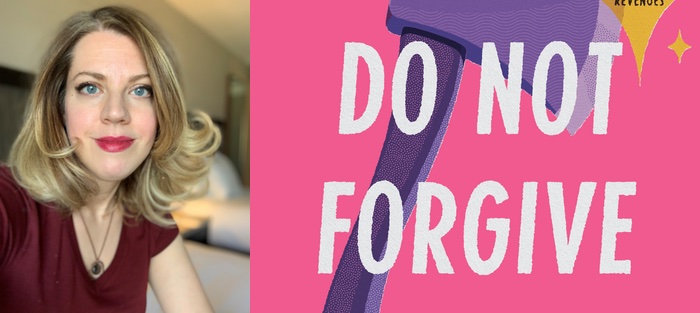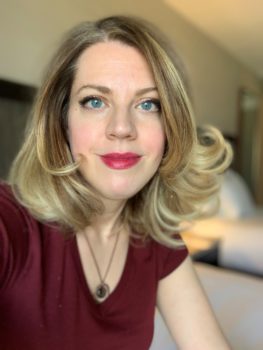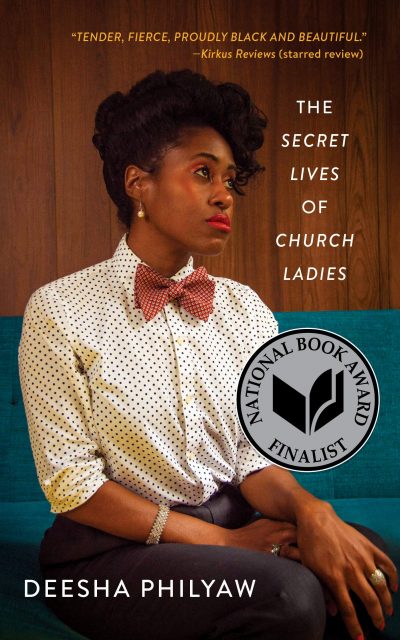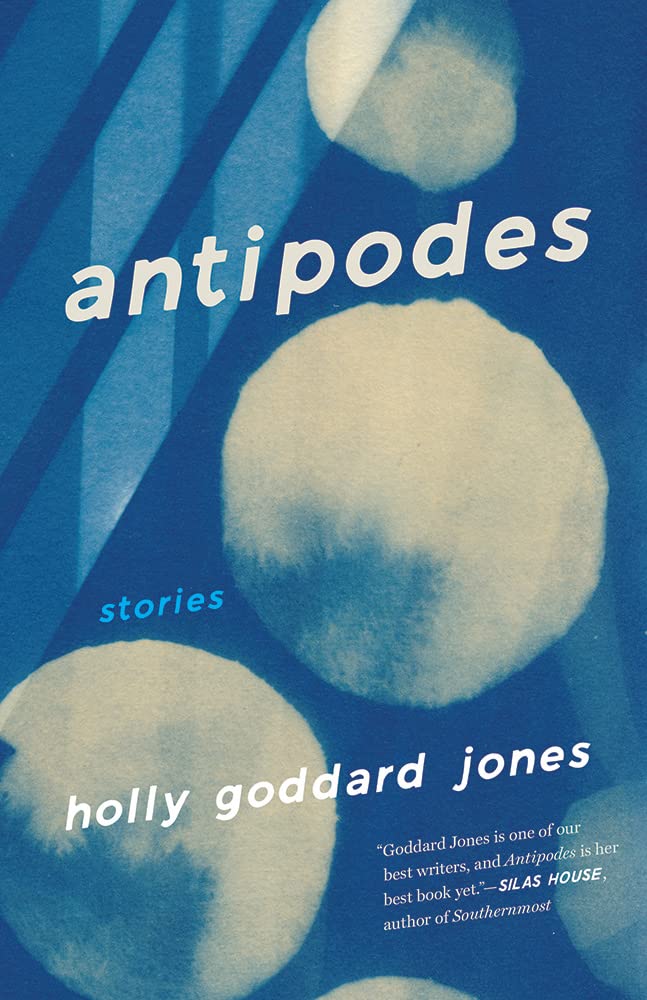A challenge so many writers face is having their work remain precisely vital in that interminable period between capturing a moment in their prose—a particular mood, a fleeting feeling about the world—and the publication of that work. With stories, this can take weeks or months. With books, it’s so much longer. Frequently, when a collection or a novel is released, it’s lost some of that vitality, and whatever flavor or heat made in the kitchen might diminish by the time it hits the table.
But not with Amber Sparks‘s stories. Consumed, they’re as alive and as delicious as when she finished them, and every single one of them kicks. Just as with her two previous collections—May We Shed These Human Bodies (Curbside Splendor, 2012) and The Unfinished World (Liveright, 2016)—Sparks’s new collection, And I Do Not Forgive You (Liveright), is a feast of burning pleasures. One reason for this is her distinct attention to style. Whether she’s juxtaposing mythologies against video game design or sending fairytale characters crashing into the harsh realities of the present day, each of her stories is a precise layering of flavors, plated by a chef with a hidden smile on her face.
In the week before her book’s release, Sparks and I had the chance to talk on the phone about And I Do Not Forgive You, dollhouses, revenge, and, of course, zombies.
Interview:
Barrett Bowlin: I know a lot of short story authors assemble their collections together like songs on an album. What are some of the threads you used to connect the stories together when assembling And I Do Not Forgive You?
Amber Sparks: This was actually an easier collection to assemble than anything else that I’ve previously put together. Obviously, there’s a unifying theme, but the reason I put together the book was because the stories I was writing all felt like they belonged together. I’d been writing these particular stories since #MeToo broke and since the Trump election, and they all had this very similar feeling. I started thinking of them as my private little revenge stories, and I didn’t really know exactly what to do with them. I told a friend what I’d been writing, and she said I should put them together as a book since other people would also like to read these “revenges,” and I hadn’t even really thought about that. But thematically, they all seemed to work together.
And I was very conscious of the fact that I wanted all of the stories to represent the viewpoints of women. There are maybe one or two stories told from a male point of view, but the rest of them are from women, and there’s of course a unifying theme there. I don’t want people to think, though, that this is just an angry book or a book of revenge; it’s a book about how people cope with trauma. Somebody pointed out to me recently that this book has a lot of people disappearing, and I think that’s also very much a theme: the ways that someone can transform or disappear, or go away, really, in response to trauma in a way that’s not a negative. Hiding, disappearing, falling away from things doesn’t have to be a weakness.
 The stories give agency to disappearing, to the act of escape.
The stories give agency to disappearing, to the act of escape.
Right. These things can be positive.
When I went back and reread the collection in parts, I noticed that the story “We Destroy the Moon” provides a lot of thematic resonance for the rest of the book. The title of the book is derived from its last line, and, in the middle of the story, in reference to the collection’s subtitle, you have the perfect sentence: “But in petty times like these, we must do what we can to keep our hurts at bay.” Do you see that as the work being done by these stories? As revenge?
I think so in a lot of ways. There’s catharsis and a sense of remove, as well. We have to do whatever we can to protect ourselves, and that’s sometimes necessary.
Not all the stories you’ve published since The Unfinished World make an appearance in the new collection. What was behind the decision-making in which stories made the cut for And I Do Not Forgive You and which didn’t?
There were pieces that I felt were more whimsical—and that’s not to say that whimsy doesn’t appear in the book—but there were pieces more on the lighthearted side that didn’t tonally feel right. There were certainly a couple of things that I wrote that had a male protagonist or were more about men, but something that my editor and I agreed on about this book was that it would 100% be about women, no matter who’s telling the story.
Lots of great symbols and props make frequent appearances in the new collection. (The diorama, for example, in stories like “The Eyes of Saint Lucy” and “Tour of the Cities We Have Lost.”) Did you ever build dioramas when you were younger?
I did but not for very long since I was a dreadful visual artist. I have no craft skills whatsoever. As a parent, I’m finding that this is really a terrible handicap. (My poor child!) But I did build some dioramas for a while there. I still like the idea of them, and I’m fascinated by the idea of artists who do that kind of work. Things like collages and dioramas and dollhouses. I’m also really fascinated by these small, shrunken down worlds.
I was reading Rachel Monroe’s Savage Appetites, and she has a wonderful chapter in there about Frances Glessner Lee, the dollhouse miniaturist whose techniques police still use to this day to examine murders. Monroe has this whole chapter about Lee and miniatures and dollhouses in particular, and she mentions this great idea about how women’s worlds were sometimes so limited that this act of building these miniatures, these small worlds, was the only way they had of dealing with it. I’ve always been meaning to write about it, but I’ll get it out there someday.
This refrain and reappearance of the dollhouses and the dioramas throughout the collection worked out really well, though. It was fascinating!
Kind of along those lines, in the research you did for some of your reclamation stories (like “You Won’t Believe What Really Happened to the Sabine Women” and “A Short and Slightly Speculative History of Lavoisier’s Wife,” for example), what was the most surprising thing you uncovered in that research?
“Sabine Women” wasn’t exactly surprising. It was more anger than surprise, really. But “Lavoisier’s Wife” was actually one of the first stories I wrote for this book. At the time, I wasn’t actually writing it for the book at all, but it was interesting because I knew I wanted to write about Marie-Anne Pierrette Paulze. She was fascinating to me, and I knew I wanted to write about her, but I wanted to write about her through this sense of erasure because using the phrase “Lavoisier’s wife” instead of her own name was playing off of her own erasure from history. And as I was researching her, I was shocked because she did things like learning several different languages just so she could translate books for only her husband, which is amazing.
At first, I wanted to write about her because she was this unsung person of history. She was described as his research assistant and his wife, and it turns out she wasn’t just a research assistant but a partner. If she’d had the education and the opportunities that he did, she would have no doubt been a brilliant scientist and scholar. It’s amazing that her name has been absolutely lost to history while his lives on.
I’ve got to say: this book is a master class in short story and flash fiction design. Who do people need to be reading right now to get a better understanding of how devastating flash fiction can be?
Well, Kathy Fish for sure. I’ve learned so much from reading her, and I think she’s actually teaching a master class on it right now. And Cathy Ulrich is someone whose work I’m incredibly interested in. She has a book just out called Ghosts of You, and every single one of her stories is just pitch perfect. And Tyrese Coleman has some amazing short shorts—just some really interesting work on form, too.
You’ve mentioned elsewhere that you started out writing in poetry, and I can see how you’ve carried this attention to meter and syntax over into your stories. Going back to pieces like “You Won’t Believe What Really Happened to the Sabine Women,” for example, you include techniques like parallelism in your clauses, cascades of infinitive phrases, lists built without conjunctions, and then these sharp, devastatingly precise sentences like “History likes to lie about women.” How and when do you know what kind of style is going to work for certain types of stories?
This is actually the central question of my work. Because I cannot write a story until I know what form it’s going to take. I know that’s not true for everyone—some people can just start writing and can change things as they go along, but I know I can’t. Instead, I edit drastically. In terms of a story’s form, I know something or someone that I want to write about, but until I find the right form and structure for it, I can’t even begin. And I’ll know, too, if when I start writing it that it begins to flounder and flop that the form is all off. Finding the right form, then, is something that needs to come to me.
I know I have to sit and think awhile on the subject matter, and then the form of the story starts looking like it’s appropriate to that subject matter. And what I mean by “appropriate” is that it’s usually opposite the subject matter. When I teach, I teach that that’s often really a powerful way to write a story. You can get a lot of impact out of a story that is incredibly emotional if you can find a form that is very factual or dry or academic even. Take “Lavoisier’s Wife,” for example—if you can find something like that and fit your subject matter to that form, it’s going to take things down a notch and pull it out from melodrama. Another one where I try to do this is my funeral piece.
“Death Deserves All Caps”?
I worked on that one for a long time, and I couldn’t figure out how to tell this story that didn’t make it sound like it was just this young woman thinking about death. Eventually, I did it in the form of these funeral wishes because it was humorous. And what’s really important to me, too, here is that the stories need to be really funny and to get humor in there so it’s not so deadly serious. I get worried each time I see a review that talks about just how angry the stories are—well, yeah, but they’re also really funny.
They are!
I don’t want people to think, “Great, I’m going to just go read this drag of a book.” But form can be a fun and easy way to inject that sense of irony and humor into a piece.
In your essays and short stories—and possibly the novel you’re working on right now?—which is more difficult for you: drafting or revising?
The drafting, absolutely. I hate writing. I hate writing so much, but I love editing. Some writers I know are able to edit as they go, and they make this amazing, beautiful prose. But me? You would not even recognize a story of mine in the first draft because so much of the language and playfulness and the humor comes much later. That first draft for me is just getting this garbage onto the page so I can do something with it.
Ah, the good ol’ “shitty first draft.” Okay, for you as a writer (both as an essayist and a short story author), who were some of the most essential authors you had to read in order to learn the craft?
Lorrie Moore for sure. And it’s funny because I had to go back and learn how to not write like Lorrie Moore. I just admired her so deeply that I wrote every single short story like it was a little, badly done Lorrie Moore story. Of course they were horrible and none of them got published, so I had to teach myself to not do that. But I’m sure I learned about humor and surprise and flow and fluidity from her work, and I’m still trying to figure out how to do that.
And George Saunders was really the author who gave me permission to be really fucking weird in stories. I hear this all the time from writers who’ve said it wasn’t until they read George Saunders that they could do [blank]. And I didn’t, either. I thought you had to write stories like Lorrie Moore or Raymond Carver, or all these fantastic writers who weren’t my style. But when I read George Saunders, I thought, Oh, my god, you can just go wild writing your stories, and you can be really funny.
Then I started reading a lot of experimental fiction writers—for example, Matt Bell. He has this story called “An Index of How Our Family Was Killed,” which is just like the title says: an index of how this fictional family is murdered. And also Blake Butler, who has all of these wild stories, and Matt Kirkpatrick, who does so much with form, and Kelly Link, who is probably my biggest influence. And more recently, there’s Carmen Maria Machado and some of the amazing things she does with form and experimentation, especially in her memoir In the Dream House. It’s just a marvel on how formal and playful and inventive it is. Being able to read all of these wonderful writers and come away from them knowing that stories don’t just have to be very solemn and serious, and instead that they can be fun and playful and that they can do anything is so freeing.
I remember how one of my first exposures to George Saunders was “Sea Oak,” which taught me it’s perfectly okay to have male strippers and zombie great aunts in a short story.
It’s so funny, too, because when I first started doing all this years ago, genre fiction was still really frowned on. If a story had this undead great aunt in it, it would be considered “zombie lit.” Half the publications I was trying to send things to said right in their guidelines, “Don’t send us anything with witches, vampires, or werewolves in it.” But it’s so different now. When I go and teach these classes and workshops now, my students are just so eager for that kind of stuff and to put it in their stories, and people will actually publish it now. There’s been so much of a sea change in publishing since then that’s been so healthy now for literature.
So now I’m curious: what’s one subject matter you’re intimidated by that you want to write about?
Good question! It’s probably something that should intimidate more white writers, frankly—writing the stories of people of color and about other cultures that are not my own. I mean, I have people of color as protagonists in some of my stories, but I’d like to do more and to write outside of my own experience a bit more. There are all of these places and people and countries that I would love to write about, and I would love to open up those experiences more, but it’s intimidating because you don’t want to get it wrong and you don’t want to appropriate.
And as a white writer, I don’t want to tell a story that writers of color are already telling, and better and more authentically than I ever could. Lord knows there’s enough of that happening right now. You don’t want to go in and just poorly reflect someone’s cultural experience, which is a heavy responsibility if you’re going to go in and try to write something like that. You’d better be researching the hell out of it, talking to a ton of people who are part of that culture, and running your stuff by them, too. I think intimidation is good—it’s unwarranted confidence that leads white writers to charge ahead thinking they can tell stories they absolutely should not be telling, in ways that are cringe-worthy at best and extremely harmful at worst.







